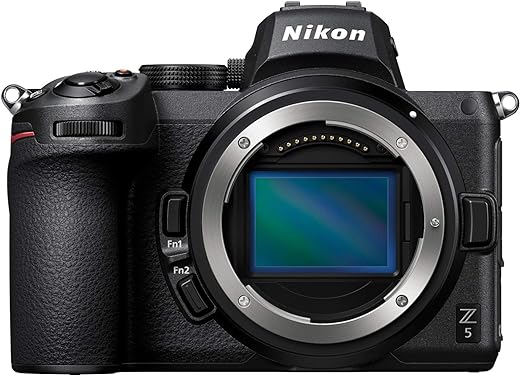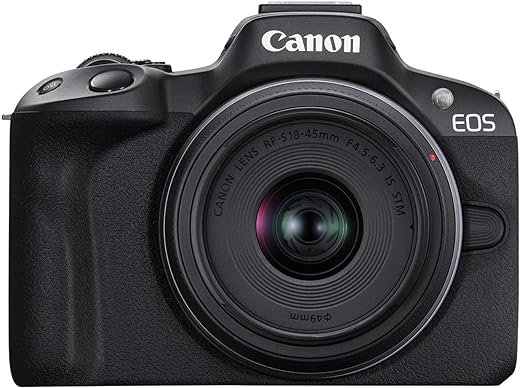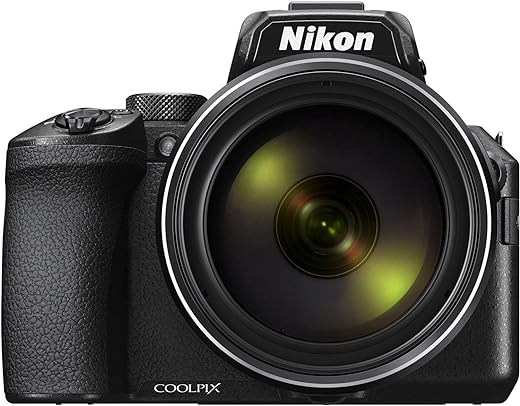When comparing the Nikon Z5 Compact Mirrorless and the Nikon Z6 Full Frame Mirrorless Camera, it’s essential to consider their key differences in size, price, and performance. The Nikon Z5 offers a more compact and lightweight design, making it a great option for travel and everyday use. On the other hand, the Nikon Z6 boasts a full-frame sensor that delivers exceptional image quality and low-light performance. By examining these two cameras side by side, we can help you determine which one best suits your photography needs.
The Nikon Z 5 is Nikon’s most compact full-frame mirrorless camera, offering outstanding image quality with vibrant colors and great low-light performance. It features 4K/30p and 1080/60p video recording, eye-detection autofocus, 5-axis in-body image stabilization, and built-in WiFi and Bluetooth for easy sharing and remote control.
Photography Enthusiasts
The Nikon Z6 Full Frame Mirrorless Camera Body delivers revolutionary optical performance with a large Z mount and 24.5MP backside illuminated image sensor. Equipped with a 273-point on-sensor Phase detect AF system, it offers impressive features like 4K Ultra-HD video, 12 fps shooting, and compatibility with a wide range of NIKKOR Z and F-mount lenses.
Nikon Z5 Compact Mirrorless
Resolution
24.3MP
Autofocus System
Eye-Detection AF
Video Recording
4K/30p, 1080/60p
Image Stabilization
5-Axis IBIS
Lens Compatibility
Z Mount lenses
Nikon Z6 Full Frame Mirrorless Camera
Resolution
24.5MP
Autofocus System
273-Point Phase Detect AF
Video Recording
4K Ultra-HD, 1080P/120Fps slow motion
Image Stabilization
Not specified
Lens Compatibility
NIKKOR Z & F-mount NIKKOR lenses
Nikon Z5 Compact Mirrorless
Nikon Z6 Full Frame Mirrorless Camera
Nikon Z5 Compact Mirrorless
Nikon Z6 Full Frame Mirrorless Camera
Comparison chart


Nikon Z 5
- USPs:
- Compact full-frame mirrorless camera.
- Excellent stills and video quality.
- Good low-light performance.
- Pros:
- Lightweight and portable.
- Great value for a full-frame camera.
- Cons:
- Slower burst shooting compared to Z6.
- Use-Cases:
- Ideal for travel and everyday photography.
Nikon Z6
- USPs:
- Superior burst shooting speed.
- High-resolution sensor.
- Versatile for various shooting scenarios.
- Pros:
- Fast and accurate autofocus.
- Excellent for low-light conditions.
- Cons:
- Higher price point.
- Use-Cases:
- Suited for professional photography and videography.
Conclusive Assessment:
If speed and burst shooting are a priority, the Nikon Z6 emerges as the winner. However, for those seeking a more budget-friendly option with good overall performance, the Nikon Z 5 is a compelling choice.
Final Summary:
In summary, the Nikon Z 5 offers a compact and affordable full-frame option suitable for general photography needs, while the Nikon Z6 caters to professionals needing faster performance and higher resolution. Choose based on your specific requirements and budget considerations.
Nikon Z5 vs Z6: Full Frame Mirrorless Showdown
Comparing Nikon Z5 Full Frame Mirrorless Camera vs Nikon Z6 Full Frame Mirrorless Camera
When comparing the Nikon Z5 and Z6 full frame mirrorless cameras, it’s essential to consider several key factors to make an informed decision.
Resolution and Sensor Size
- Z5: 24.3MP full-frame CMOS sensor
- Z6: 24.5MP full-frame CMOS sensor
Autofocus System
- Z5: 273-point hybrid AF system
- Z6: 273-point phase-detection AF system
ISO Range
- Z5: ISO 100-51200
- Z6: ISO 100-51200 (expandable to 204800)
Image Stabilization
- Z5: In-body image stabilization (IBIS)
- Z6: In-body image stabilization (IBIS)
Video Capabilities
- Z5: 4K video recording at 30fps
- Z6: 4K video recording at 30fps (10-bit 4:2:2 output via HDMI)
Price Point
- Z5: Generally more budget-friendly
- Z6: Higher price point due to additional features
Lens Compatibility
- Both cameras are compatible with Nikon Z-mount lenses
Key Considerations
- Assess your photography needs: Are you primarily shooting stills or video?
- Evaluate budget constraints: Determine the features most important to you within your budget.
- Consider lens compatibility: Ensure the camera you choose aligns with your existing or desired lens lineup.
By considering these factors and your specific requirements, you can choose between the Nikon Z5 and Z6 full frame mirrorless cameras that best suit your needs.
Comparing Nikon Z5 and Z6 Mirrorless Cameras
Of course! The main differences between the Nikon Z5 and Z6 models lie in their capabilities and features. The Nikon Z5 is known for being our most compact full-frame mirrorless camera, ideal for both stills and video. On the other hand, the Nikon Z6 is a full-frame mirrorless camera that excels in overall performance and higher-end features.
The Z6 offers a higher resolution EVF, faster continuous shooting speed, better low-light performance, and more autofocus points compared to the Z5. Additionally, the Z6 has a higher-end video recording capability with advanced features for videographers.
Ultimately, the choice between the Nikon Z5 and Z6 would depend on your specific needs and budget, as the Z6 offers more advanced features for those seeking a higher level of performance.
When comparing the autofocus systems of the Nikon Z5 and Z6, there are some differences in performance. The Nikon Z6 generally offers a more advanced autofocus system compared to the Z5. The Z6 features a more sophisticated autofocus system with more focus points and advanced tracking capabilities, making it better suited for capturing fast-moving subjects or tracking subjects across the frame. On the other hand, the Z5’s autofocus system is also reliable but may not have the same level of speed or precision as the Z6. Overall, if you prioritize autofocus performance, the Z6 might be the better choice between the two models.
When comparing the sensor sizes of the Nikon Z5 and Z6, it’s important to note that both cameras feature full-frame sensors. The Nikon Z5 has a 24.3-megapixel full-frame CMOS sensor, while the Z6 boasts a higher resolution 24.5-megapixel full-frame CMOS sensor.
In terms of image quality, the larger sensor size in both cameras allows for better light sensitivity and improved low-light performance compared to cameras with smaller sensors. The Z6’s slightly higher resolution may provide a bit more detail in images, especially when cropping or printing large photos.
Ultimately, both the Nikon Z5 and Z6 offer excellent image quality due to their full-frame sensor sizes, with the Z6 potentially edging out in terms of resolution.
The Nikon Z5 Compact Mirrorless camera is more compact and lighter than the Nikon Z6 Full Frame Mirrorless camera. The Z5 measures approximately 5.3 x 4.0 x 2.8 inches and weighs around 20.7 ounces, while the Z6 is larger and heavier, measuring about 5.3 x 4.0 x 2.7 inches and weighing around 23.8 ounces. So, if portability and weight are important factors for you, the Z5 might be the better choice.
When comparing the price point of the Nikon Z5 Compact Mirrorless and Nikon Z6 Full Frame Mirrorless cameras, the Nikon Z5 usually tends to be more budget-friendly than the Nikon Z6. The Nikon Z5 is positioned as a more entry-level full-frame mirrorless camera option, offering some advanced features at a more accessible price point. On the other hand, the Nikon Z6 is a higher-tier model with enhanced specifications and capabilities, which generally reflects in its higher price. So, if you are looking for a more affordable full-frame mirrorless camera, the Nikon Z5 might be the better choice for you.
The key difference in image sensor resolution between the Nikon Z5 and Z6 is that the Z5 has a 24.3-megapixel full-frame sensor, while the Z6 has a higher resolution 24.5-megapixel full-frame sensor. This means that the Z6 may provide slightly more detailed images compared to the Z5.








7 thoughts on “Nikon Z5 vs Nikon Z6”
It would have been helpful to include sample photos taken with both cameras for reference.
As a potential buyer, this article helped me understand which model suits my needs better.
Overall, a well-written and useful comparison for someone looking to invest in a Nikon mirrorless camera.
I found the comparison between the Z5 and Z6 very informative.
The article did a great job highlighting the differences in features and performance.
The pricing information provided was really useful for making a decision.
I wish there was more emphasis on the image quality comparison between the two cameras.
Comments are closed.